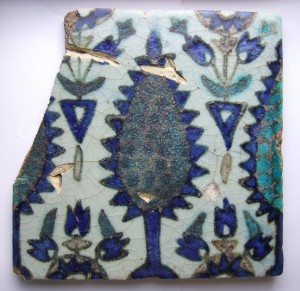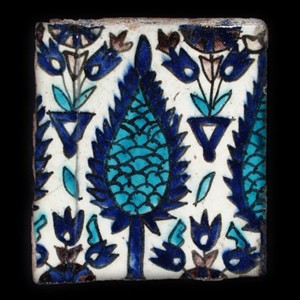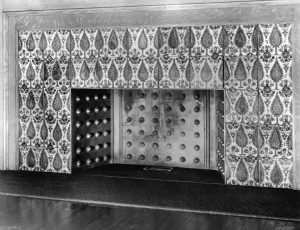I’ve done some poking about since I last wrote about my mystery tile. (Click on all photos to enlarge).
I had discounted it being Iznik as most Iznik decorative floral motifs I had seen were flowing and sinuous, rather than angular and geometric, as in my tile.
However, a late-night spot of google-fu brought me to the official blog of the Glessner House Museum in Chicago. In the mid 1880s Iznik tiles which date from the mid-16th century were used to decorate the fireplace of the newly built Glessner House. The photos on the Glessner House website are very similar to my tile:
However, it is not clear from the blog whether this is one of the 1970s reproductions that is mentioned, or one of the three original tiles that survive from the Glessner House collection. (Update: this very tile is for sale at Anthony Slayter-Ralph Fine Art, Tile 70 of the Lockwood de Forest II collection, 21.6 x 19 cm (8.5 x 7.5 in.), so I am not sure how accurate the Glessner House information is. The sale description says it can be compared to two tiles in the V&A, accession no. 1227-1883, but sadly there are no photos with the V&A’s collections database entry for these tiles).
This tile differs from my tile in that the interior of the flower spike is painted to delineate the fish scale-like sections, whereas mine has a bumpy, textured interior and the sections are more circular. The Glessner ones are said to be some 6 inches square (although the one above is 8.5 x 7.5 inches), whereas mine is a tad over 8 inches square. Plus my underglaze background colour is a blueish white, whereas the Glessner House ones are a cleaner, crisper white.
The Glessner House blog provided a photo of similar tiles in the tomb of Muhi al-Din Ibn ‘Arabi in the Sheikh Muhiddin Mosque in Damascus. Another quick google told me that he was properly known as (deep breath) ‘Abū ‘Abdillāh Muḥammad ibn ‘Alī ibn Muḥammad ibn ‘Arabī (also as Muhiddin(e) ibn Arabi), an Arab-Andalusian Sufi mystic, poet and philosopher who died in 1240 AD, and was buried in Damascus. Centuries later his tomb was decorated with these vivid Iznik tiles. They too have the painted fish scale-like interior divisions of the flower spikes.
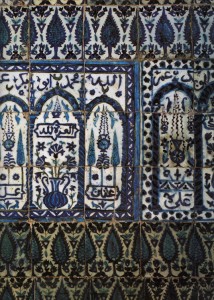
Iznik tiles in the tomb of ‘Abū ‘Abdillāh Muḥammad ibn ‘Alī ibn Muḥammad ibn ‘Arabī in Damascus. These have the painted fish scale divisions within the flower spikes.
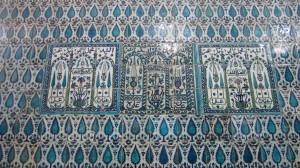
Ibn Arabi’s tomb, Damascus, Syria. Photo from http://hakkani.wordpress.com/2011/04/30/sheikh-ibn-arabis-tomb-jabal-qasyoon-syria/
So the question is, is mine Iznik too? Is it genuine Iznik, older than the ones at Damascus? Is it genuine Iznik, younger than the ones at Damascus? Was it made by another pottery centre, apeing the Iznik style? Is it a modern reproduction? I don’t think it is the latter as it simply looks and feels too old: it was made in a fairly crude way, the glaze is very crackled and crazed with age, and it has had a life with all its breaks and stains. But I could very easily be wrong.
Time for some more research ….
UDATE: More developments here.
